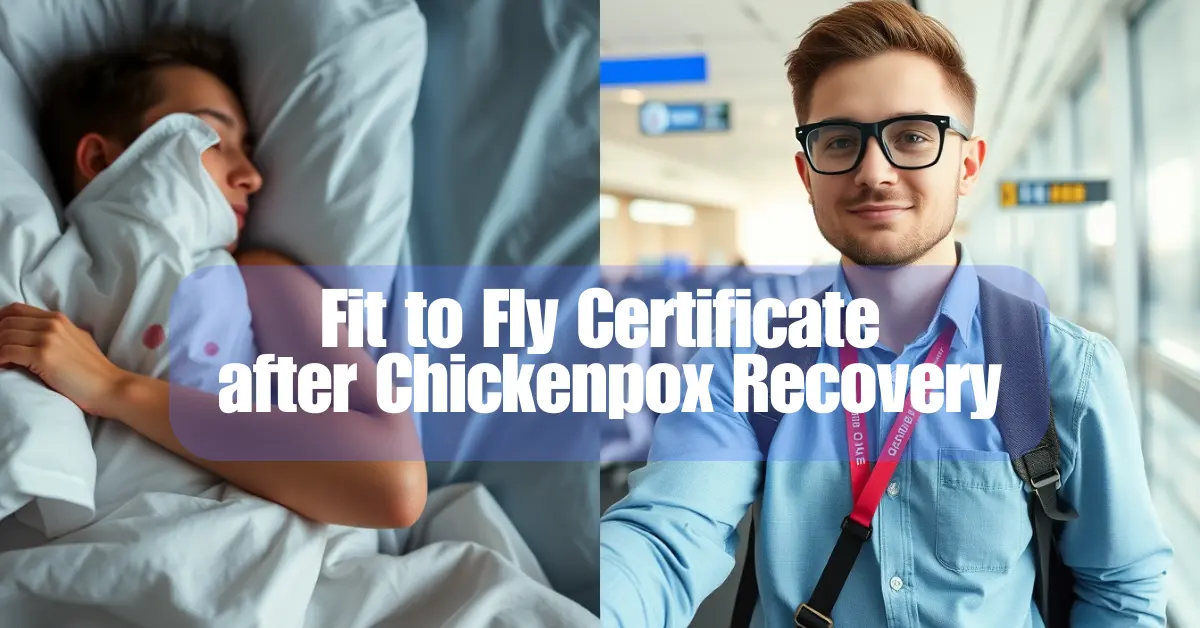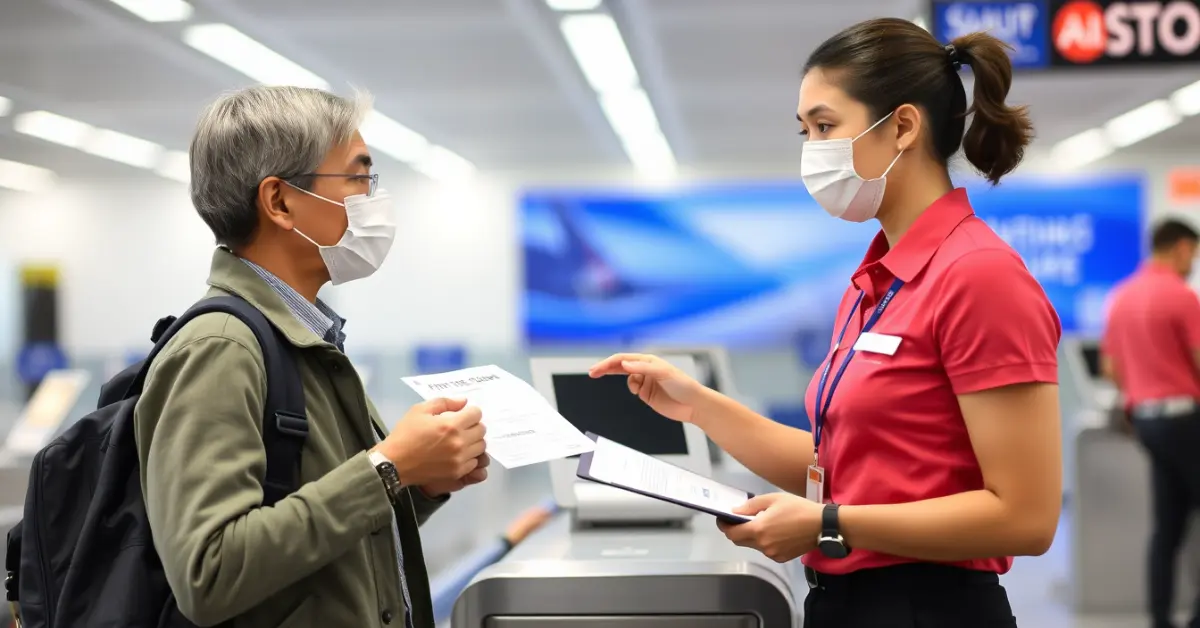Fit to Fly Certificate after Chickenpox
We are dedicated to providing you with convenient online Fit to Fly certificates following chickenpox recovery without the need for a clinic visit.
Anytime Clinic offers straightforward access to Fit to Fly certificates specifically for individuals who have recently recovered from chickenpox, ensuring safe travel post-recovery.
Through a quick online consultation, users can receive GP-reviewed documentation, often within the same day. This certificate confirms your fitness to fly after recovering from chickenpox, assuring airlines and fellow travelers of your health status.
LET'S GET STARTED



Frequently
Asked Questions
How Long Is Chickenpox Contagious?
Chickenpox remains highly infectious from 1-2 days before the rash appears until all blisters crust over. The infectious period typically lasts 5-6 days after the rash first develops.
Can I Fly If I’ve Been Exposed to Chickenpox but Don’t Have Symptoms?
Flying after exposure without symptoms is generally permitted. Monitoring for signs of infection remains essential before travel. Airlines don’t restrict passengers who’ve been exposed but remain symptom-free.
Are There Any Medications That Can Speed Up Recovery for Travel Purposes?
No medications accelerate chickenpox recovery for faster travel clearance. The virus must run its natural course until all spots crust over.
What Should I Do If I Develop Chickenpox Symptoms While on Holiday?
Isolate immediately in your accommodation. Contact your travel insurance provider for medical assistance. Avoid public transport until cleared by a local doctor.
Can Children with Chickenpox Fly?
Children must follow the same restrictions as adults. Airlines require all blisters to be fully crusted over. A fit to fly certificate becomes mandatory for children travelling shortly after recovery.
Are There Any Special Precautions for Pregnant Travellers Exposed to Chickenpox?
Pregnant travellers exposed to chickenpox need immediate medical attention. Contact an obstetrician before any travel plans. Avoid flying if exposure occurred within 21 days.
How Do Airlines Verify If a Passenger Has Recovered from Chickenpox?
Airlines require a fit to fly certificate issued within 6 days of travel. Staff inspect visible skin areas during check-in. Medical documentation must confirm all spots have crusted over.
Can I Be Denied Boarding If I Have Visible Chickenpox Scabs?
Airlines may deny boarding with visible active blisters. Fully crusted scabs typically don’t cause issues. Carrying a fit to fly certificate helps prevent boarding complications.
What Are the Risks of Complications from Flying with Chickenpox?
Flying with active chickenpox increases transmission risks to other passengers. Cabin conditions can worsen skin irritation. Recovery complications may arise from stress during travel.
How Does Cabin Pressure Affect Chickenpox Symptoms?
Cabin pressure changes can intensify skin discomfort. Low humidity levels dry out healing blisters. Air conditioning may increase itching sensations during the flight.

Planning a trip while dealing with chickenpox can be incredibly stressful. We understand the uncertainty and concerns about whether you can fly with chickenpox and what precautions you need to take.
Before you pack your bags, it’s crucial to understand the risks and regulations surrounding air travel in this highly contagious condition. Airlines take health matters seriously especially when it comes to infectious diseases that could spread to other passengers. We’ll guide you through everything you need to know about flying with chickenpox, including airline policies, medical recommendations, and alternative travel options.
Key Takeaways
- Airlines strictly prohibit flying with active chickenpox – most UK carriers require a minimum 7-day waiting period after the last spot appears
- A fit to fly certificate is mandatory for travel after chickenpox recovery, costing £20-£50 from UK clinics and valid for 6 days
- Complete crusting of all blisters and absence of fever are essential requirements before considering air travel
- Major airlines like British Airways and Ryanair offer flexible rebooking options with proper medical documentation
- Travel insurance typically covers chickenpox-related cancellations, but pre-existing conditions must be declared
Understanding Chickenpox and Air Travel Risks
Chickenpox presents significant risks during air travel due to its highly contagious nature. The virus spreads through respiratory droplets and direct contact with blister fluid in enclosed spaces like aircraft cabins.
The most infectious period occurs within the first 2 to 5 days after symptoms appear. Travelling during this window poses transmission risks to other passengers, particularly those with compromised immune systems.
Commercial airlines maintain strict protocols about passengers with active chickenpox infections. Most UK carriers require a minimum 7-day waiting period after the last spot appears before allowing travel.
| Airline | Chickenpox Policy Requirements |
|---|---|
| British Airways | Medical clearance needed |
| Ryanair | 7-day waiting period |
| Aer Lingus | Pre-flight notification |
Visible chickenpox blisters result in immediate flight denial across all major airlines. This policy protects other passengers and crew members from potential exposure during the flight.
Primary symptoms that affect flight eligibility include:
- Open or weeping blisters
- Fresh spots or rashes
- Fever or flu-like symptoms
- General feelings of illness
Medical professionals recommend postponing travel until all blisters have crusted over. This typically takes 5 to 7 days from the initial outbreak.
A fit to fly certificate becomes mandatory when travelling shortly after recovery. This document confirms the passenger is no longer contagious and safe to travel.
Can You Fly with Chickenpox?
Flying with chickenpox requires careful consideration of airline policies and medical guidelines. Most commercial airlines enforce strict regulations about passengers with active chickenpox infections.
General Guidelines
Airlines require passengers with chickenpox to present a fit to fly certificate from a healthcare provider. The certificate must confirm the individual is no longer contagious and should be issued within 6 days of travel.
Key requirements for flying include:
- Waiting 7 days after the last spot appears
- Ensuring all spots have crusted over completely
- Being free from fever or other symptoms
- Obtaining medical clearance documentation
Contagious Period Considerations
The chickenpox virus remains highly transmissible during air travel within enclosed cabin spaces. The most infectious period spans the first 5 days after spots appear.
Critical timing factors:
- Peak contagion occurs 2-5 days after rash onset
- Transmission risk remains until all blisters crust
- Recovery typically takes 5-7 days from outbreak
- Airlines mandate specific waiting periods based on symptom progression
| Chickenpox Stage | Required Wait Time |
|---|---|
| Active spots | No flying permitted |
| Last new spot | Minimum 7 days |
| Crusted blisters | 24-48 hours |
| Full recovery | Medical clearance |
The virus spreads through direct contact and airborne droplets in confined spaces. UK carriers monitor passengers for visible signs of infection during check-in and boarding processes.
Airline Policies on Flying with Chickenpox
Airlines enforce strict regulations for passengers with chickenpox to prevent virus transmission during flights. These policies protect all passengers while maintaining safety standards in confined aircraft spaces.
Major Airlines’ Restrictions
British Airways permits travel 6 days after the final blister appears and forms a crust. Passengers must present documentation confirming they’re no longer infectious.
| Airline | Minimum Waiting Period | Additional Requirements |
|---|---|---|
| British Airways | 6 days | Doctor’s letter required |
Required Medical Documentation
A fit to fly certificate is essential for travelling after chickenpox recovery. This document confirms:
- The passenger’s infectious period has ended
- All spots have crusted over completely
- No active fever or symptoms exist
- The exact date of the last spot appearance
The certificate must be:
- Issued within 6 days before the flight
- Signed by a registered healthcare professional
- Written in English
- Include the doctor’s contact details
- State clearly the patient is fit for air travel
Each airline maintains specific documentation requirements. It’s essential to contact the carrier directly to verify their current policies before booking travel arrangements.
The policy strictness varies during peak infectious periods. Medical clearance becomes mandatory when visible signs of chickenpox remain, even if they’ve started healing.
Fit to Fly Certificate for Chickenpox
A Fit to Fly certificate acts as official medical clearance for passengers recovering from chickenpox. Airlines require this documentation to protect all passengers during air travel.
Purpose of the Certificate
The certificate confirms a passenger’s non-infectious status after chickenpox recovery. It’s a formal document that assures airlines their passenger poses no transmission risk to others onboard.
Medical professionals evaluate specific criteria before issuing this certificate:
- Signs of recovery from chickenpox
- Absence of new spots for at least 7 days
- Complete crusting of all existing spots
- No fever or active symptoms
How to Obtain One in the UK
Getting a Fit to Fly certificate involves visiting a GP or travel clinic in the UK. Here’s what to expect:
1. Book an appointment with your GP or local travel clinic
2. Attend a physical examination to verify:
- All spots have crusted over
- No new spots in the past 7 days
- Absence of fever
3. Receive the certificate containing:
- Your personal details
- Date of examination
- Doctor’s signature
- Medical registration number
- Contact information
The certificate remains valid for 6 days from the date of issue. UK airlines like British Airways accept these certificates when presented at check-in with other travel documents.
Costs for obtaining the certificate vary between £20-£50 at different UK clinics. Private travel clinics often offer same-day appointments compared to NHS GP services.
Timeframe for Flying After Chickenpox
Timing is crucial when planning air travel after a chickenpox infection. Airlines maintain specific policies about when passengers can fly after experiencing chickenpox symptoms.
Recommended Waiting Periods
A 7-day waiting period applies after the last chickenpox spot appears. Major UK airlines including Ryanair, easyJet, Jet2, TUI and Virgin Atlantic enforce this timeline strictly.
British Airways sets a 6-day waiting requirement from when the final blister appears and scabs over. A doctor’s letter confirming non-infectious status accompanies this requirement.
| Airline | Required Waiting Period |
|---|---|
| Ryanair | 7 days |
| easyJet | 7 days |
| Jet2 | 7 days |
| TUI | 7 days |
| Virgin Atlantic | 7 days |
| British Airways | 6 days |
Factors Affecting Recovery Time
Several factors influence how quickly chickenpox spots crust over:
- Age: Adults often experience longer recovery periods compared to children
- Immune system strength: Robust immunity speeds up healing
- Severity of infection: More extensive rashes require additional healing time
- Skin care routine: Proper blister care accelerates crusting
- Rest levels: Adequate sleep supports faster recovery
The infectious period ends once all spots have completely crusted over. Monitoring each spot’s progression helps determine flight eligibility.
Obtaining a fit to fly certificate becomes possible only after meeting these recovery milestones. Medical professionals assess spot crusting progress before issuing travel clearance.
Risks Associated with Flying and Chickenpox
Flying with chickenpox presents significant health risks due to its highly contagious nature in enclosed aircraft cabins. Airlines enforce strict regulations against passengers with active chickenpox infections to protect everyone’s safety.
Health Risks for the Infected Passenger
The infected passenger faces several physical challenges during air travel:
- Cabin pressure changes can intensify discomfort from chickenpox fever
- Dry cabin air irritates existing blisters causing increased itching
- Fatigue from the infection becomes more pronounced at high altitudes
- Limited movement in aircraft seats may aggravate skin discomfort
- Air conditioning systems can worsen fever symptoms
Potential Risks to Other Travellers
Chickenpox transmission poses serious threats to fellow passengers:
- The virus spreads through airborne droplets within the enclosed cabin space
- Close seating arrangements increase exposure risk for nearby passengers
- Vulnerable groups face heightened dangers:
- Pregnant women
- Elderly passengers
- Young children
- People with compromised immune systems
| Risk Factor | Transmission Window | Required Waiting Period |
|---|---|---|
| Initial Symptoms | 2-5 days | No flying permitted |
| Active Blisters | Up to 7 days | Must be fully crusted |
| Post-Recovery | After crusting | Need fit to fly certificate |
The virus remains highly contagious until all blisters crust over completely. UK airlines require passengers to obtain a fit to fly certificate confirming they’re no longer infectious before boarding any flights.
Doctor’s Note Requirements

A fit to fly certificate confirms passengers’ recovery from chickenpox before boarding flights. Airlines require this documentation to protect all passengers’ health safety.
When a Doctor’s Note is Necessary
A doctor’s note becomes essential when planning air travel within 6 days after chickenpox recovery. Major UK airlines mandate medical documentation for passengers who’ve recently experienced chickenpox symptoms.
British Airways requires certification if travelling within 6 days of the final blister appearance. Ryanair EasyJet TUI Virgin Atlantic enforce similar policies requiring documentation within 7 days of the last spot.
What the Note Should Include
The fit to fly certificate must contain specific details to be valid for air travel:
- Full name date of birth of the passenger
- Date of examination
- Confirmation that all spots have crusted over
- Statement declaring the passenger is no longer infectious
- Date when the last new spot appeared
- Doctor’s official signature registration number
- Medical practice contact information
- Issue date validity period
The certificate remains valid for 6 days from the issue date. UK medical clinics charge £20 to £50 for these assessments certificates.
Passengers must present the original certificate at check in. Photocopies digital versions aren’t accepted by most airlines.
Travel Insurance and Chickenpox
Travel insurance plays a vital role when chickenpox affects your travel plans. Standard policies offer emergency medical coverage ranging from £10 million to unlimited protection.
Coverage for Chickenpox-Related Cancellations
Travel insurance policies cover trip cancellations caused by chickenpox diagnosis. Most UK insurers reimburse non-refundable expenses including:
- Flight tickets
- Hotel bookings
- Pre-paid activities
- Transport arrangements
Coverage activates when a GP confirms the chickenpox diagnosis. The policy pays out cancellation costs if the infection occurs during the covered period.
Importance of Declaring Pre-Existing Conditions
Pre-existing conditions require disclosure to travel insurers for valid coverage. Here’s what UK travellers must declare:
- Active chickenpox infections
- Recent recovery from chickenpox
- Any ongoing symptoms
- Current medical treatments
Non-disclosure invalidates the insurance policy. Medical screening questions determine coverage eligibility based on:
| Screening Criteria | Impact on Coverage |
|---|---|
| Time since diagnosis | Higher premium if within 14 days |
| Severity of infection | May affect coverage limits |
| Current symptoms | Could restrict policy benefits |
| Age of traveller | Influences risk assessment |
Insurance providers need documentation of recovery status. A fit to fly certificate supports insurance claims when travelling after chickenpox recovery.
Alternatives to Flying with Chickenpox
Passengers diagnosed with chickenpox have several options to manage their travel plans when flying isn’t possible. Alternative arrangements protect both the affected traveller and other passengers while minimising financial impact.
Rescheduling Options
Most UK airlines offer flexible rebooking for passengers with chickenpox. British Airways permits free date changes when presented with a doctor’s note confirming the diagnosis.
Ryanair allows passengers to move their flight dates up to 4 weeks ahead at no extra charge with medical documentation. These options remain valid until the passenger meets the airline’s fitness criteria for travel.
The optimal rebooking window spans 14 to 21 days from diagnosis, allowing adequate time for complete recovery. This timeframe ensures passengers meet the required 7-day waiting period after the last spot appears.
Cancellation Policies
Airlines maintain specific cancellation terms for medical conditions like chickenpox. British Airways offers full refunds with proper medical documentation submitted within 24 hours of diagnosis.
Ryanair provides vouchers valid for 12 months when cancellations stem from chickenpox infections. The airline requires:
- A doctor’s note confirming the diagnosis
- Notification at least 4 hours before departure
- Submission of medical evidence within 7 days
- Diagnosis confirmed by a GP
- Documentation submitted within policy timeframes
- Claims filed before the scheduled departure
| Airline | Rebooking Window | Cancellation Refund |
|---|---|---|
| British Airways | Up to 12 months | Full refund available |
| Ryanair | Up to 4 weeks | 12-month voucher |
| EasyJet | Up to 6 months | Refund minus fees |
Managing Chickenpox Symptoms During Travel
Flying with chickenpox symptoms requires careful management and preparation to minimise discomfort during the journey. This section outlines essential tips and packing requirements for passengers who’ve received medical clearance to fly.
Tips for Comfort if Travel is Unavoidable
- Keep skin moisturised with fragrance-free lotions to prevent itching in the dry cabin air
- Choose loose-fitting cotton clothing to reduce irritation of healing blisters
- Request an aisle seat for easy access to toilets when applying creams
- Stay hydrated by drinking water every hour during the flight
- Take prescribed antihistamines 30 minutes before departure
- Apply calamine lotion before boarding to soothe irritated skin
- Move around the cabin every 2 hours to maintain circulation
- Use a neck pillow to prevent skin contact with seat fabric
Useful items to carry
- Calamine lotion in a 100ml travel-size bottle
- Antihistamine tablets prescribed by your GP
- Fit to fly certificate in an easily accessible folder
- Loose cotton clothing for layering
- Cooling spray within airport liquid limits
- Fragrance-free moisturiser for dry skin
- Clean cotton gloves to prevent scratching
- Antibacterial hand gel
- Bottled water
- Fresh gauze pads
- Medical report showing recovery status
- Travel insurance documents with chickenpox coverage
Each item serves a specific purpose in managing chickenpox symptoms during the flight. Remember to pack medications in their original packaging with prescription labels intact.
Conclusion
Flying with chickenpox requires careful consideration and proper planning. We’ve outlined the essential requirements including waiting periods medical documentation and airline policies to help you make informed decisions about your travel plans.
Remember, your health and the wellbeing of fellow passengers should always be the priority. With proper medical clearance adherence to airline regulations and careful timing we can ensure safe and comfortable air travel after chickenpox recovery.
If you’re unsure about your fitness to fly always consult a healthcare professional and contact your airline directly. They’ll provide the most up-to-date guidance for your specific situation.
